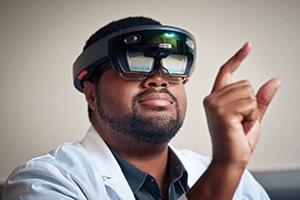NYU adapting VR technology to tell a pathology ‘story’
April 2019—The R&B classic “Time Is on My Side” may be an anthem for rejected lovers, but a new virtual reality teaching tool that allows students to “visit” the pathology lab without leaving the classroom may soon have NYU medical students humming the song’s refrain.
The experiential learning content, being developed collaboratively by multimedia specialists and pathologists, is designed to “maximize students’ time by condensing complex information,” says Greg Dorsainville, senior multimedia developer for NYU’s Institute for Innovations in Medical Education. Case in point: He took an hour of footage for the project’s pilot video, which shows a pathologist demonstrating a colorectal cancer staging. The final product clocks in at six minutes.

Greg Dorsainville, senior multimedia developer at NYU’s Institute for Innovations in Medical Education, experiments with virtual reality technology for pathology. (Photos courtesy of NYU Langone Health)
But the content isn’t merely intended as a timesaver for overstretched students. Dorsainville and Amy Rapkiewicz, MD, vice chair of pathology at NYU Winthrop Hospital, hope it will help teach pathology concepts—and how decisions made at the grossing table affect patient care—to medical students who have limited access to the pathology lab and no preclinical standalone courses in the specialty.
In the 1970s, says Dr. Rapkiewicz, who is also director of the integrated anatomy, histology, and pathology course at the NYU Long Island School of Medicine, medical schools began revising their preclinical curriculums to follow a systems-based approach in which traditional sciences like pathology are taught as a component of courses on the organ systems. “This was spurred on by the finding that students seemed to do better contextualizing the basic sciences when they’re learning about clinical sciences at the same time,” she explains. Consequently, educators have had to determine not only what to teach students in their preclinical years but how to teach it to them.
This led to a eureka moment of sorts that developed organically from a long collaborative partnership between Dorsainville and Dr. Rapkiewicz, who initially worked together to create a digital catalog of pathology specimens. The two moved away from that project, Dr. Rapkiewicz says, after realizing students were unlikely to benefit from the library without a structured didactic approach.
But Dr. Rapkiewicz, a forensic pathologist and autopsy director, had repeatedly seen material click for students who visited the autopsy suite and interacted directly with specimens. When she shared this insight with Dorsainville, he suggested immersive content, giving students “a feeling of presence, as if they’re standing next to the professor in the lab.”
Dorsainville, an experienced videographer who’s been working with immersive technologies for three years, uses a 360-degree wide-angle camera to film the video content. The camera, which captures a much larger field of vision than a traditional video camera, “gets as much of the view as possible but also gives a stereo feel,” he says.
The videos, which can be viewed from a virtual reality headset or a desktop computer, aren’t difficult to develop from a technical standpoint. What’s tricky, Dorsainville says, is “creating a viable educational experience.”
The example video of the colorectal cancer staging is in usability testing with a group of preclinical students at the NYU School of Medicine. All content will be pilot tested before becoming part of the curriculum. Because crafting an effective pedagogical strategy is challenging, Dr. Rapkiewicz is working with colleague Margret Magid, MD, pathology content director, on how best to implement the videos in integrated coursework.
In the meantime, the development team is focused on creating content that has what Dr. Rapkiewicz calls “a robust pathology story.” A post-chemotherapeutic osteosarcoma, for example, has a clean narrative with an illustrative surgical specimen. A lesson featuring an osteosarcoma might show the x-ray, chemotherapeutic effect, and surgical amputation, culminating with the oncologic targets and revealing the extensive role pathologists play in a patient’s downstream clinical management. A sarcoma of the soft tissue, which “kind of looks like a blob,” would not be a good candidate, she notes.

Dr. Rapkiewicz
“A lot of times I see people make wonderful simulations or innovative VR content and it’s something I may be able to explain to students [by drawing] on a napkin,” Dr. Rapkiewicz says with a laugh. “We’re really trying to use it to fit the technology with the problem.”
For preclinical instruction, this means using the content to augment areas of the curriculum for which students might need “extra context to understand how pathology and disease are represented in the body,” Dr. Rapkiewicz says. For clinical instruction, she envisions directing students to supplementary pathology material—for example, students on a surgery rotation might be given a list of immersive videos to view after observing a gallbladder surgery. This “just-in-time learning” will be essential for students who don’t have time to “follow their specimen to the pathology lab,” she adds.
The first project of Dorsainville and Dr. Rapkiewicz to be incorporated into the preclinical curriculum is tangential to pathology. Beginning this fall, students in the general anatomy course at the NYU Long Island School of Medicine will use virtual prosection modules, in lieu of cadavers, in the introductory anatomy course. “Our strategy right now is to follow responsive design—for all this content to be accessible in some format, regardless of whether students have a headset, computer, or mobile device,” explains Dorsainville. “All experiences will be available via the Web. For true immersion, students will have access to devices loaned by the school.”
Dorsainville, meanwhile, hopes to further develop other virtual reality pathology content by adding an interactive component that allows students to manipulate digital models of the tissue, similar to what he’s done with the prosection modules.
“The only thing really lacking,” he says, “is that you can’t walk around and pick things up.” —Charna Albert
Xifin adds functionality to LIS and RCM system
Xifin has announced a strategic partnership with Glidian under which Glidian will integrate its automated prior authorization capabilities with the Xifin RPM revenue cycle management solution and Xifin’s laboratory information system.
“By integrating our electronic prior authorization submissions with Xifin RPM and Xifin LIS, we’re able to help providers streamline their workflows, prevent denials, and help expedite decisions to make sure patients receive the important diagnostic information they need,” said Ashish Dua, CEO of Glidian, in a press statement. The application works with the existing prior authorization workflow, logic, and document storage in Xifin RPM.
 CAP TODAY Pathology/Laboratory Medicine/Laboratory Management
CAP TODAY Pathology/Laboratory Medicine/Laboratory Management
